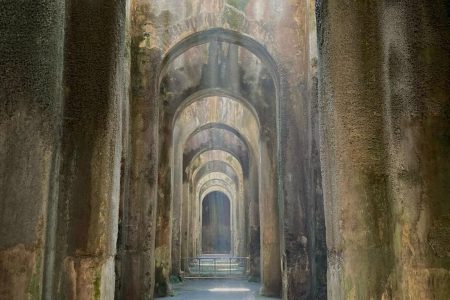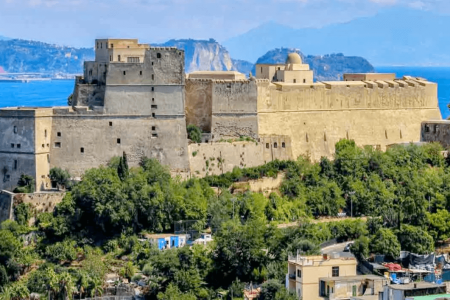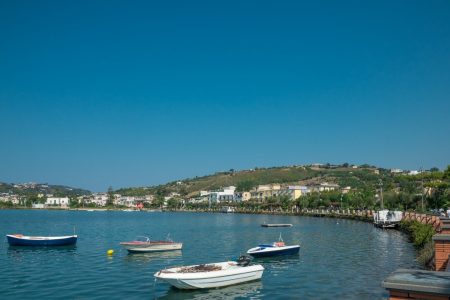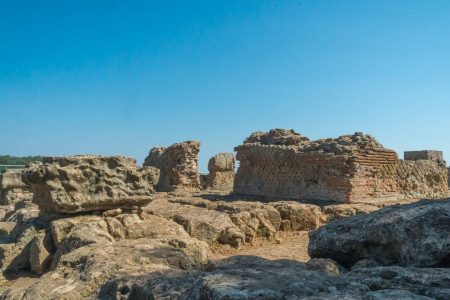Table of Contents
The Aragonese Castle of Baia is one of the main points of interest in the Phlegrean area located in the hamlet of the same name in the municipality of Bacoli. The building was erected on a promontory 50 meters above sea level and is set between a sheer tufa cliff and a depression created by the calderas of volcanoes known as Bay Funds.
Surrounded by drawbridges, moats and high walls, the castle was virtually impregnable to enemies, and its strategic location allowed the entire harbor area to be controlled, preventing enemy fleets from approaching. Because of its location in relation to other attractions in the Phlegrean area, Baia Castle is the current home of the Archaeological Museum of the Phlegraean Fields which houses most of the artifacts found at Phlegraean sites.
The centuries-old history of Baia's Aragonese Castle
In Roman times the promontory was occupied by a residential complex, the remains of which have been destroyed and partly incorporated into the present castle structure. Construction of the fortress was begun by the Aragonese in 1495, shortly before the arrival of the French of Charles VIII. For the project the king Alfonso II of Aragon relied on the collaboration of the Sienese architect Francesco di Giorgio Martini, known for his innovative techniques in the field of military defenses.
Following the eruption of Mt. New, the viceroy don Pedro de Toledo decided to undertake a total renovation of Baia Castle, which thus assumed its present appearance. The building maintained its function as a military fortress even during the period of Austrian rule and during the Bourbon reign.
In 1734 the building was seriously damaged in the course of the Bourbon war against the Austrians, and for this reason it was further fortified and restored by Charles III of Bourbon. After the Unification of Italy, Baia's Aragonese Castle experienced slow abandonment and in 1887 came under the control of various ministries.
You might be interested
Guided tour inside the enchanting Piscina Mirabilis
per person Book
Shared guided tour of Baia Castle every first Sunday of the month
per person Book
Guided tour in the Historic Center of Bacoli
per person Book
Tour of the Cumae Excavations with a stop at the Casina Vanvitelliana
per person Book
In 1927 he was then sold to the Royal military orphanage and in the next three years new modifications were made. Instead during World War II the castle was used as a military prison for prisoners of war. Only in 1980 did its management pass into the hands of the Campania Region, and in 1984 it was finally taken over by the Archaeological Superintendence of Naples and Caserta so that it could house the Archaeological Museum of the Phlegraean Fields.
To admire its timeless beauty we recommend this guided tour of the Castle of Baia. The activity takes place every first Sunday of the month and allows you to see the exhibits in the museum's enchanting rooms. In addition, there is a magnificent view of the Gulf of Pozzuoli from the top of the castle.
The Archaeological Museum of the Phlegraean Fields
The Aragonese Castle in Baia is home to the Archaeological Museum of the Phlegraean Fields, where one can see a great many historical artifacts found at major sites in the Phlegraean area. The rooms inside the building display objects from the Earth District of Pozzuoli, the reconstruction of the Sacellum of the Augustals at Miseno, the plaster casts found at the Baths of Baia, and the findings at the Nymphaeum of Punta Epitaffio.
The different sections then include nineteenth-century collections of Cumaean artifacts, artifacts of Samnite origin, fragments from sanctuaries of the Greek era, marbles of Roman origin, and other finds from the Byzantine era.
Instead in the Powder Room an exhibition entitled "The Visible, the Invisible and the Sea" can be visited. It is dedicated to the statue of enthroned Zeus that has returned to the Phlegraean Fields from the Getty Museum in Los Angeles. In addition to these works, 11 other sculptures from the deposits of the Phlegraean Fields Archaeological Park are on display that tell the story of the Phlegraean area's relationship with the sea, between emersion and immersion due to the phenomena of bradyseism.
The Archaeological Museum of the Phlegraean Fields is open 9:00 a.m. to 8:00 p.m. every day except Monday. As for tickets, the full ticket costs €5, while the reduced ticket costs €2.





0 Comments